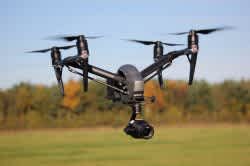
Training & Regulations
Published on 1 Dec 2017
James Willoughby
A Guide to Operation Manuals
Heliguy Insider looks into the Operations Manual required as part of commercial drone training to obtain a PfCO. ... Read More

Heliguy Training

Operations Manual

Heliguy Guide
What’s known as an Operations Manual is actually one section of an Operating Safety Case (OSC). There are two main sections that are usually required for first-time applicants of a PfCO. These are Volume 1 – Operations Manual and Volume 2 – Aircraft Systems. The details in each of the volumes is required by the CAA however, the layout and appearance should be designed to reflect the processes and aesthetic of your company.
Volume 1 – Operations Manual
Volume 1 provides information on your company intentions for drone operation. Before getting into the sections of this volume, you must detail the following areas:
Safety Statement – Completed by the Accountable Manager detailing how the company will safely operate the aircraft. The statement must include the Accountable Manager’s digital signature.
Amendment Record – A table with updates of any changes and amendments made to the manual.
Referenced Documents – Detail any source information you used such as Civil Aviation Publications.
Acronyms and Abbreviations – Include an explanation of all used as part of your manual, even if they’re commonly known.

Introduction
This section is designed to give an overview of your company and the contents of the manual. You should also include your intent and strategy for your commercial drone operations. You should include contact details of the Accountable Manager for any queries relating to the manual.
Safety Policy
This section is for you to include the safety details of your company. You should cover your company as a whole in addition to your drone operation. Include any existing company policies relating to safety in this section such as health and safety policies.
Organisation

Operations
This section is for you to detail information on the specific procedures relating to your flight operations. Operating Limitation and Conditions – Provide detail on the operating limitations and conditions specific to your weight classification of aircraft in accordance with the regulations. Risk Management – Explain how your organisation will conduct risk management and how hazards and risks will be assessed. More information on what to include in an assessment can be found here. https://www.heliguy.com/blog/2017/09/28/drone-safety/ Communication – Discuss how the crew will keep in contact with themselves and any third-parties such as air traffic controllers or the emergency services. Pre-Notification – Detail what process will be used if operating in or close to an Aerodrome Traffic Zone, controlled airspace, aircraft operating site or potentially sensitive site. Outline who will be notified and by what means. Site Permissions – Detail the procedure for gaining landowner permission and how you will record it. Weather – Note the method used for obtaining the weather reports with a focus on the impact on aircraft operation as well as onsite weather readings such as wind speed, precipitation and visibility. Determine Intended Tasks and Feasibility – Discuss how you will assess the feasibility and safety of each flight from the planning stage up to the flight. Appendices should be included as applicable. Operating Site Planning and Assessment – Provide information on the planning and assessment of the operating site. This should include factors such as controlled airspace, NOTAMs, physical hazards and all other relevant information. Onsite Procedures – The following sections should be detailed: site survey, operating area, crew briefing, cordon procedure, communication, weather checks, refuelling, and loading of equipment. Pre-Flight Assembly and Functions Check – Summarise the checks completed prior to flight. A separate pre-flight checklist should be created to be used before each flight and filed as an appendix. Flight Procedures – Include a basic description of flight operation and who is responsible for each area. During and Post Flight Check – Detail checks completed within and after the flight. Emergency Procedures – Detail the procedure of what will happen in different emergency scenarios. You should include what the event may be, pilot response, crew response and any follow-up action that may be required. Appendices The following documents could be included as an attachment to your Operations Manual, dependent on what you have discussed:
Final copy of your PfCO once issued by the CAA
A copy of your insurance documents. Insurance should cover you for your Flight Assessment
Maintenance log for aircraft inspection and repairs
Tasking request form including the preliminary information on tasks and clients
Pre-site planning form for airspace information, risk assessments etc.
On-site survey for immediately before the flight
Incident log to record the details of any job incidents
A log book for all flight times
Battery log for charging and discharging

Volume 2 – Aircraft Systems

General Operations Manual Tips
Here are some general tips to keep in mind when you’re writing your Operations Manual:
If you use terms like ‘ALARP’, make sure you use them in the right context. Using phrases and acronyms without a thorough understanding will waste the time of the NQE and may result in a rejection of that version from the CAA.
Do your research! Know what you’re talking about.
Make the information clear. Don’t try to sound intelligent and use ‘big’ words. The Operations Manual can be hard enough to understand so just keep it simple.
We’ve said it many different times in different ways but make sure it’s an original piece of work created by you. Don’t buy templates or pay for services to write the details for you.
Keep in mind that everything you write in the manual, you will have to do on every single flight. Only include what’s necessary.
If in doubt, speak to your NQE. They’re there to help you through each stage of the process so use them when you need them.
Why Choose Heliguy

Other Training Available from Heliguy
As well as Heliguy’s PfCO training course, several other training options are available through Heliguy:
New Pilot Event – In partnership with DJI, Heliguy offer a free monthly event in their Newcastle training facility. Attendees will be given an overview of DJI’s product range, an insight into the drone industry including businesses and basic air law and have a chance to get some hands-on experience with drones.
Drone Video Editing Course – In Heliguy’s Newcastle office, a video editing course is available. The course is a beginner's guide on how to capture the best drone footage and edit into something commercially worthwhile.
ES-Dot Training – Tailor-made training for the emergency services including the Police, Fire & Rescue, Ambulance, Mountain Rescue, Coast Guard and control centre support staff for the deployment of UAS.
Flight Assessment Preparation – A training day design to help prepare you for your flight assessment. We will deliver a theory refresher, discuss case studies and deliver individual advice and support.
NQE Adoption – For a candidate who have completed their Ground School with another provider or have a PPL or CPL licence. We will arrange a refresher or help with the submission of your Operations Manual and Flight Assessment.
To discuss becoming a commercial drone pilot, other Heliguy training, or any DJI or Freefly product, please give one of our team a call on 0191 296 1024 or email us at info@heliguy.com.
Keep checking back to Heliguy’s Insider Blog for more announcements, insights into drones and, of course, the latest news from the drone industry.
